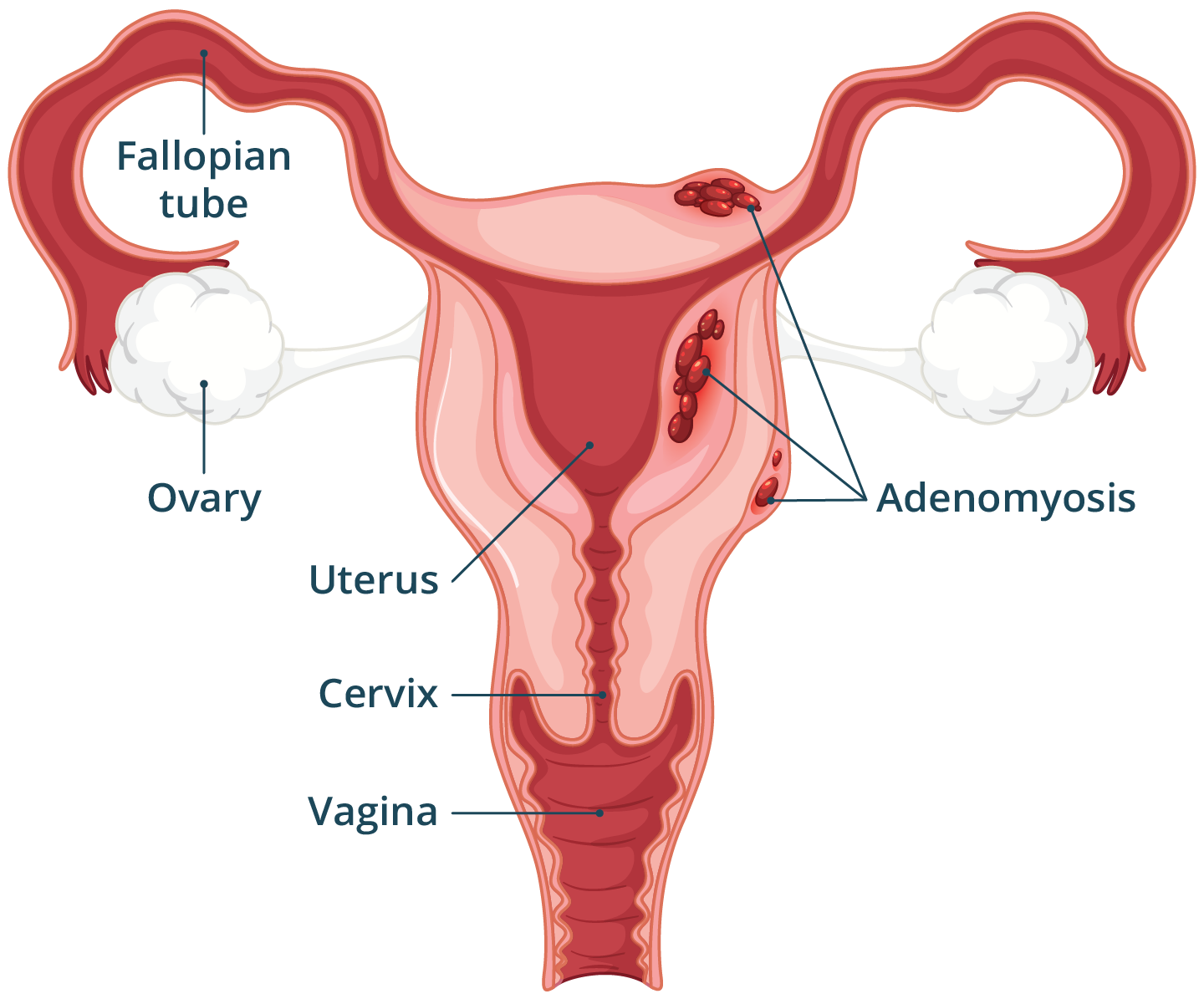Adenomyosis
Key facts
- Adenomyosis is a condition that affects your uterus (womb).
- It's when the cells that normally line the inside of your uterus also grow in the muscle layer of your uterus.
- It can cause heavy and painful periods.
- Your doctor may recommend an ultrasound scan or MRI scan to help diagnose adenomyosis.
- Treatment will depend on your symptoms and stage of life, including whether you want to become pregnant in the future.
What is adenomyosis?
Adenomyosis is a condition that affects your uterus (womb). It happens when the cells that normally line the inside of your uterus also grow in the muscle layer of your uterus.
Adenomyosis can cause painful and heavy periods.
It's thought that about 1 in 5 females has adenomyosis. It usually affects females who have periods aged between 30 and 50 years.
If you have adenomyosis, you might also have endometriosis. The features of these 2 conditions can overlap.

What are the symptoms of adenomyosis?
Symptoms of adenomyosis can include:
- heavy periods
- prolonged periods
- painful periods
- pain during sex
- chronic (ongoing) pain in the pelvis
Your symptoms may be mild. But they can also be severe enough to interfere with your work, study and enjoyment of life.
Sometimes, there are no symptoms.
CHECK YOUR SYMPTOMS — Use the Symptom Checker and find out if you need to seek medical help.
What causes adenomyosis?
Adenomyosis occurs when the cells that normally line the inside of your uterus also grow in the muscle layer in the wall of your uterus.
It's not certain how or why the uterus-lining cells enter the muscle wall.
Your risk of adenomyosis may be increased if you have had surgery or other procedures on your uterus.
When should I see my doctor
See your doctor if you have painful or heavy periods.
Also see your doctor if:
- your symptoms stop you from doing your usual activities
- you have any unusual vaginal bleeding
- you have pain when having sex
FIND A HEALTH SERVICE — The Service Finder can help you find doctors, pharmacies, hospitals and other health services.
ASK YOUR DOCTOR — Preparing for an appointment? Use the Question Builder for general tips on what to ask your GP or specialist.
How is adenomyosis diagnosed?
Your doctor will ask you about your symptoms and examine you. They may ask to do a vaginal examination.
If you have had heavy bleeding, your doctor may organise blood tests. These can check your iron levels and red blood cells.
Your doctor might recommend a pelvic ultrasound scan. A vaginal ultrasound may give clearer images of your uterus — this is where the ultrasound probe is gently inserted into your vagina. This test should be explained to you, and you will be asked to give your consent beforehand.
In some cases, your doctor may recommend an MRI scan.
Your doctor may also refer you to a gynaecologist for further tests and treatment.
How is adenomyosis treated?
Your doctor will talk with you about the different treatments available.
The choice of treatment will depend on your symptoms and life stage. This includes thinking about whether you are planning a pregnancy or want to have a baby in your future.
Self-care measures
You may want to try warm baths and heat packs to help relieve your pain.
You could also try TENS. But there is little research showing that this can improve the symptoms of adenomyosis.
Pain-relief medicines
If you have pain associated with adenomyosis, your doctor may recommend a trial of anti-inflammatory medicines. They may suggest that you take these medicines with paracetamol.
Hormonal treatments
Hormonal treatments can help relieve your pain and reduce heavy periods.
Your doctor may recommend:
- a hormonal intrauterine device (IUD)
- the pill (combined oral contraceptive pill)
- a progestogen-only pill
- a hormone-releasing contraceptive implant
These hormonal treatments are forms of contraception. So, you will not be able to get pregnant while using them properly.
It can take several months for your fertility to return after stopping some of these treatments. Talk to your doctor about the most suitable treatment for your stage of life.
Surgery
There are some surgical procedures that can be considered for the treatment of adenomyosis. These may involve removing:
- abnormal areas of the muscle layer of your uterus
- the lining of your uterus
A hysterectomy may be an option if you have severe adenomyosis symptoms and have not responded to other treatments.
Talk to your doctor about what would be a suitable option for you. This is important as these treatments can affect your fertility.
What are the complications of adenomyosis?
Adenomyosis can cause complications such as:
- fertility problems
- a higher risk of pregnancy complications
- anaemia or iron deficiency due to heavy vaginal bleeding
Can adenomyosis be prevented?
As the cause of adenomyosis is not fully understood, there is nothing you can do to prevent this condition.
Resources and support
Support is available through Adenomyosis Australia.
You can find more information on adenomyosis at Endometriosis Australia.
You can also call the healthdirect helpline on 1800 022 222 (known as NURSE-ON-CALL in Victoria). A registered nurse is available to speak with you 24 hours a day, 7 days a week.
Learn more here about the development and quality assurance of healthdirect content.
Last reviewed: September 2024










